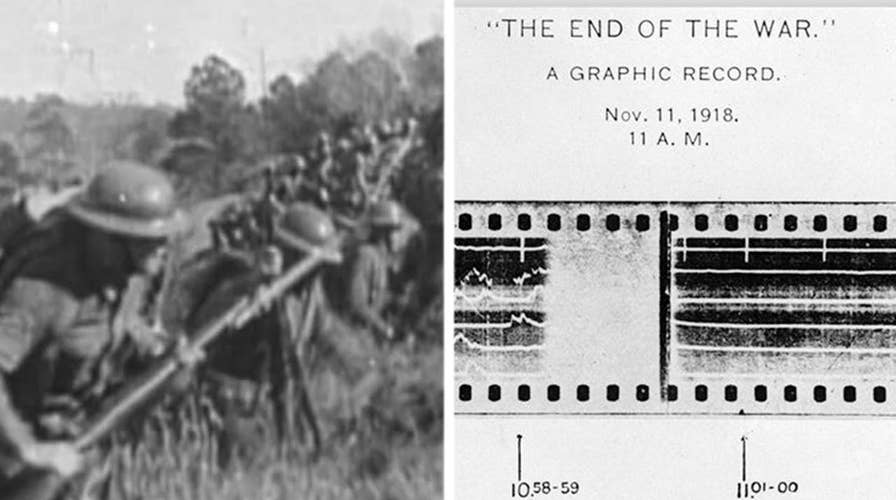Picture this: You’re a soldier on the American front near the River Moselle during WWI. You’ve been informed Germany has signed the Armistice agreement, ending four long years of death and destruction that killed 9 million soldiers and injured millions of others.
All around you, though, the roaring sound of gunfire and deafening explosions continue until the very last minute -- making it seem as though the battle will never truly end. But as the clock strikes 11 a.m. on Nov. 11, 1918, the guns abruptly fall silent and the war is finally over.
WORLD WAR I: 100 YEARS ON, THE US REMEMBERS THE END OF THE ‘GREAT WAR’
The Imperial War Museums (IWM) in Britain, in a partnership with sound designers at London-based Coda to Coda, has created a way for history-lovers around the world to relive how the Great War likely sounded moments before its end.
The sound designers have paired a reimagined audio recording with an original graphic record that shows the exact moment the war ended.
The graphic record is a “product of sound ranging, a technique used by the Allies to determine the location of enemy artillery,” the IWM London states in a press release provided to Fox News.
“Photographic film was used to record the exact moment that the sound of a gun firing was received by six different microphones. Because the microphones were located far apart, they picked up the sound from the same gun at slightly different times,” IWM explains in the release, adding the different times were then used to locate the position of a specific gun or piece of artillery.

The graphic record shows the minute before and after the Armistice agreement went into effect. (IWM)
The graphic record tracked “the noise intensity at any one moment,” which, much like a seismograph, would then transfer the sound “onto a rolling piece of photographic film,” German broadcaster Deutsche Welle explains online.
“It’s visually interesting to see the flat lines after the sound [of firing] has stopped,” Richard Hughes, an IWM curator, told Fox News in a phone interview Friday, adding the sound designers have “put together a synthesized soundtrack that gives an impression of what it might have been like.”
The firing “literally [continued] up until a second or two before it [Armistice] went into effect,” he added.
Although the Armistice was signed at 5 a.m. that same day, it didn’t take effect until 11 a.m. In a statement, a spokesperson for the National WWI Museum and Memorial in Kansas City told Fox News an estimated 3,000 soldiers were killed “unnecessarily” during those six hours.
WORLD WAR I POSTERS OFFER UNIQUE GLIMPSE INTO SOLDIERS' STORIES 100 YEARS AFTER THE ARMISTICE
Those who visit the museum can not only hear the entire soundtrack -- based on the graphic recording from 10:58 a.m. to 11:01 a.m. -- but can also feel a reproduction of the vibrations soldiers at the time likely felt as well.
"We hope that our audio interpretation of sound ranging techniques... enables visitors to project themselves into that moment in history and gain an understanding of what the end of the First World War may have sounded like,” Will Worsley, the director and principal composer at Coda to Coda, said in a statement, adding the document “gives us great insight into how intense and chaotic the barrage of gunfire must have been for those fighting on the western front.”

